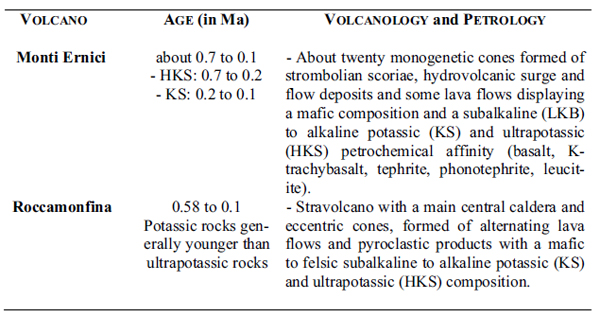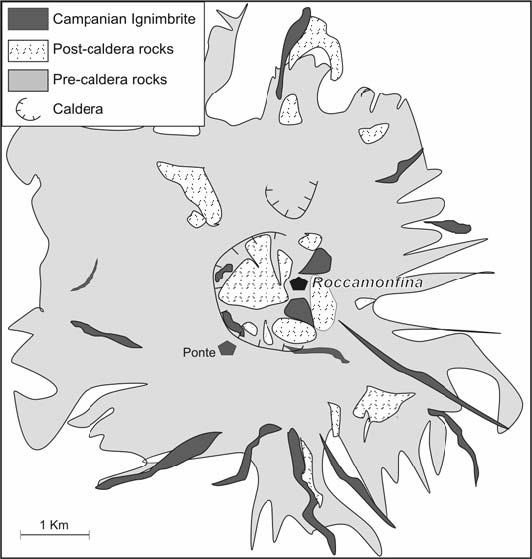Provincia magmatica Ernici-Roccamonfina
The Monti Ernici and Roccamonfina volcanoes are located south of the Roman Province, between the Ancona-Anzio and Ortona-Roccamonfina tectonic lines. The Ernici volcanoes consist of a series of about twenty monogenetic pyroclastic and lava centres with an age of 0.7 to 0.1 Ma. The Roccamonfina volcano is a stratocone with a large central caldera, formed by lava flows, domes and pyroclastic deposits emplaced between about 0.6 and 0.1 Ma. Early studies recognised two distinct rock series in the Ernici and Roccamonfina volcanoes: a potassic series (KS) and a high-potassium series (HKS), showing distinct enrichments in potassium, incompatible elements and Sr-Nd isotopic signatures. Apeculiarity of the Ernici-Roccamonfina Province is the close association of rocks with a very wide range of enrichment in potassium, incompatible trace element and radiogenic isotope compositions.
Location map of Ernici (full triangles) and Roccamonfina volcanoes. (Peccerillo, 2005).

Age, petrology and volcanology of Ernici and Roccamonfina volcanoes. (Peccerillo, 2005).
Roccamonfine Volcano
Roccamonfina is an asymmetric truncated composite cone, with a base diameter of about 20 km and a 6 km wide, NW-SE-elongated summit caldera that is breached on the east side. The caldera floor, sited at about 600 m above sea level, hosts several lava flows and domes which reach a maximum altitude of about 1000 m.
Schematic geological map of the Roccamonfina volcano. (Peccerillo, 2005).
The volcano is composed of alternating lava flows, domes and pyroclastic deposits which were emitted both from central and parasitic vents between about 0.6 and 0.1 Ma. Rock compositions range from mafic to felsic, and from subalkaline to alkaline potassic and ultrapotassic. The volcanic activity took place in a zone of NW-SE trending extensional faults cut by younger N-S faulting. Most authors agree that the volcano developed in three main stages.
A first stage dominated by emission of phonotephritic and tephriphonolitic lava flows and minor pyroclastics built up the main cone. Successively, large explosive eruptions formed several phonotephritic-phonolitic and trachytic pyroclastic deposits, the most prominent of which are known as the Brown Leucitic Tuff (BLT) and the White Trachytic Tuff (WTT). These rock units are associated with volcanic events that are believed to be responsible for caldera collapses, although it has been suggested that the caldera(s) may be formed as the result of rock removal by explosive eruptions.
The final phases of activity were characterised by the emplacement of lava flows, domes and some scoria cones both inside the caldera and along the flanks of the stratovolcano.
The lowest exposed products of the cone have an age of about 550 ka. However, tephra recovered from the nearby areas have shown a somewhat older age of about 580 ka, which most probably represents the beginning of the volcanic activity at Roccamonfina. The youngest lava from the main cone has an age of about 370 ka. The BLT and WTT sequences result from various eruptions that occurred from about 380 to 230 ka. The activity inside the caldera and along the cone flanks developed between about 300 and 100 ka. The Roccamonfina volcanic rocks range in composition from mafic to felsic. They exhibit a wide range of alkali contents and straddle the boundary between the subalkaline and alkaline fields of Irvine and Baragar (1971). The subalkaline rocks are silica undersaturated low-potassium basalts (LKB). The KS rocks include K-trachybasalts, shoshonites, latites and trachytes. The ultrapotassic rocks range from leucite-tephrite to phonolite.
The LKB and KS basalts (potassic trachybasalts) are variably porphyritic with phenocrysts of, diopside to salite clinopyroxene, which appears colourless to green in this section, and some plagioclase set in a groundmass composed of the same phases plus Fe-Ti oxides. Biotite is present in small amounts. The evolved KS rocks have porphyritic textures with phenocrysts of clinopyroxene, plagioclase, biotite and sanidine.
The HKS mafic rocks are generally porphyritic with variable amounts of olivine, clinopyroxene and leucite phenocrysts set in a groundmass containing the same phases plus plagioclase, some nepheline and sanidine. The tephriphonolites and phonotephrites contain clinopyroxene, plagioclase, leucite and biotite phenocrysts, whereas phonolites are generally dominated by sanidine, some clinopyroxene, leucite and glass. Xenoliths of various origins, including metamorphic and sedimentary wall rocks and cumulate lithologies, are found at Roccamonfina.
The mafic magmas from Ernici and Roccamonfina volcanoes display variable abundances and ratios of incompatible elements as well as very distinct isotopic signatures. These were probably generated in a vertically zoned heterogeneous mantle source which was modified by two temporally and compositionally distinct metasomatic events. These episodes of mantle metasomatism may be related to subduction of the Adriatic plate beneath central Italy, followed by the arrival of new subduction-related material from the Ionian plate.
Bibliography
• Peccerillo. A. Plio-Quaternary Volcanism in Italy. (2005)



.jpg)
.jpg)
.jpg)
.jpg)
.jpg)
.jpg)
.jpg)
.jpg)
.jpg)
.jpg)
.jpg)
.jpg)
.jpg)
.jpg)
.jpg)
.jpg)
.jpg)
.jpg)
.jpg)
.jpg)
.jpg)
.jpg)
.jpg)
.jpg)
.jpg)
.jpg)
.jpg)
.jpg)
.jpg)
.jpg)
.jpg)
.jpg)
.jpg)
.jpg)
.jpg)
.jpg)
.jpg)
.jpg)
.jpg)
.jpg)
.jpg)
.jpg)